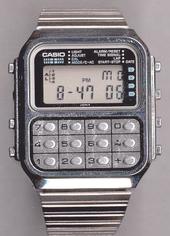Calculator watches first appeared in the Mid 1970s and were introduced by Pulsar and Hewlett Packard. Several watch manufacturers have made various qualities of calculator watches over the years, but the Japanese electronics company Casio, is the most prolific.
Casio has produced a plethora of models over the years and is considered the main player in calculator watches.
In the mid-1980s, Casio also created the Data Bank calculator watch, which not only performed standard mathematical functions, but also stored appointments, names, addresses, and phone numbers. Currently, Casio sells only a few "pure" calculator watches (i.e. CA-58W) and consider a calculator as merely a function on their Data Bank watches. The eData version of its Data Bank watch, that features these aforementioned storage capabilities, also has greater memory and the ability to store computer passwords.
When calculator watches first appeared in the early 1980s, (the golden age being the mid 80s) the high-tech community demand created a "feature war" of one-up-manship between watch manufacturers (i.e. Casio scientific calculator watch CFX-400 in 1985) and also were considered fashionable or hip.
However, as the novelty of this new electronic fad watch wore off, they became, much like pocket protectors and thick glasses, associated with nerds and were no longer considered to be in vogue.
Today, the overall style status of the calculator watch is uncertain. Depictions of them in today’s media abound, but with no single type of wearer.
With the recent geek chic phenomenon gaining momentum, many fashion commentators predict that the calculator watch, like thick-rimmed Henry Kissinger-style eyeglasses and Members Only jackets, will become a must-have fashion accessory for the intellectual hipster.
In addition to their questionable status as a fashion accessory, the future of the calculator watch as a practical and useful electronic device is also uncertain. In an age of ubiquitous PDAs, cell phones, and other powerful and compact computing devices capable of storing many megabytes of information, there likely may not be much of a need for a digital watch that holds a fraction of the information and displays it on a tiny monochromatic screen and has hard to use miniature buttons. On the other hand, one could also argue that advances in electronics and voice recognition could result in many qualities of PDAs, cell phones, and other powerful and compact computing devices being incorporated into a watch format (just as the Data Bank absorbed the calculator function, TV controller, and camera in some models). PCOnHand.com offered a PC/PDA/calculator wrist watch but, as of April 07, 2006 have ceased selling this device.
